Prerequisition
安装Go
$ echo "export GOPATH=/home/parallels/go" > .zshrc
$ echo "export GOROOT=/usr/lib/go-1.14" > .zshrc
安装Java
安装Zookeeper
安装 autoconf
$ sudo apt-get install autoconf
手动编译
$ sudo mkdir -p $GOPATH/src/github.com/CodisLabs
$ cd $_ && git clone https://github.com/CodisLabs/codis.git -b release3.2
$ echo "export PATH=$GOPATH/src/github.com/CodisLabs/codis/bin:$PATH" > ~/.zshrc
$ sudo make
Binary
$ curl -OL https://github.com/CodisLabs/codis/releases/download/3.2.2/codis3.2.2-go1.8.5-linux.zip
$ unzip codis3.2.2-go1.8.5-linux.zip
$ cd codis3.2.2-go1.8.5-linux
启动
启动 codis-dashboard
$ # vim config/dashboard.toml
coordinator_name = "zookeeper"
# 这里填你的ZooKeeper的地址
coordinator_addr = "127.0.0.1:2181"
product_name = "codis-demo"
启动
$ nohup ./codis-dashboard --ncpu=4 --config=config/dashboard.toml --log=logs/dashboard.log --log-level=WARN &
# 如果开启多个shell tab,则直接以实时查看Log
$ ./codis-dashboard --ncpu=4 --config=config/dashboard.toml
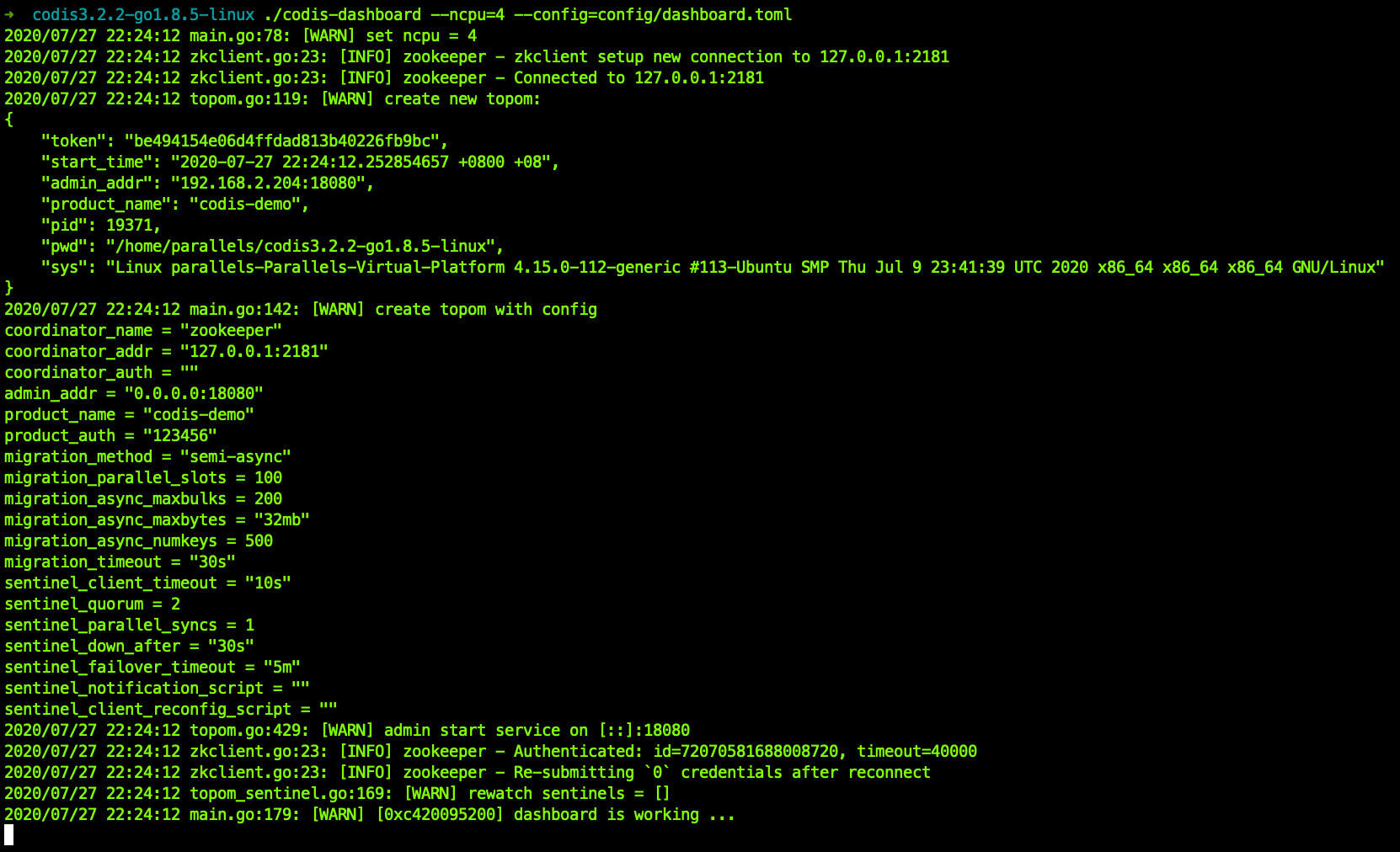
默认工作在18080端口。
$ ./codis-dashboard -h
Usage:
codis-dashboard [--ncpu=N] [--config=CONF] [--log=FILE] [--log-level=LEVEL] [--host-admin=ADDR] [--pidfile=FILE] [--zookeeper=ADDR|--etcd=ADDR|--filesystem=ROOT] [--product_name=NAME] [--product_auth=AUTH] [--remove-lock]
codis-dashboard --default-config
codis-dashboard --version
Options:
--ncpu=N set runtime.GOMAXPROCS to N, default is runtime.NumCPU().
-c CONF, --config=CONF run with the specific configuration.
-l FILE, --log=FILE set path/name of daliy rotated log file.
--log-level=LEVEL set the log-level, should be INFO,WARN,DEBUG or ERROR, default is INFO.
默认配置文件
$ ./codis-dashboard --default-config | tee dashboard.toml
##################################################
# #
# Codis-Dashboard #
# #
##################################################
# Set Coordinator, only accept "zookeeper" & "etcd" & "filesystem".
# for zookeeper/etcd, coorinator_auth accept "user:password"
# Quick Start
coordinator_name = "filesystem"
coordinator_addr = "/tmp/codis"
#coordinator_name = "zookeeper"
#coordinator_addr = "127.0.0.1:2181"
#coordinator_auth = ""
# Set Codis Product Name/Auth.
product_name = "codis-demo"
product_auth = ""
# Set bind address for admin(rpc), tcp only.
admin_addr = "0.0.0.0:18080"
# Set arguments for data migration (only accept 'sync' & 'semi-async').
migration_method = "semi-async"
migration_parallel_slots = 100
migration_async_maxbulks = 200
migration_async_maxbytes = "32mb"
migration_async_numkeys = 500
migration_timeout = "30s"
# Set configs for redis sentinel.
sentinel_client_timeout = "10s"
sentinel_quorum = 2
sentinel_parallel_syncs = 1
sentinel_down_after = "30s"
sentinel_failover_timeout = "5m"
sentinel_notification_script = ""
sentinel_client_reconfig_script = ""
| 参数 | 说明 |
|---|---|
| coordinator_name | 外部存储类型,接受 zookeeper/etcd |
| coordinator_addr | 外部存储地址 |
| product_name | 集群名称,满足正则 \w[\w\.\-]* |
| product_auth | 集群密码,默认为空 |
| admin_addr | RESTful API 端口 |
启动 codis-proxy
codis-proxy 配置
# vim config/proxy.toml
product_name = "codis-demo"
jodis_name = "zookeeper"
jodis_addr = "127.0.0.1:2181"
$ nohup ./codis-proxy --ncpu=4 --config=config/proxy.toml --log=logs/proxy.log --log-level=WARN &
# 如果开启多个shell tab,则直接以实时查看Log
$ ./codis-proxy --ncpu=4 --config=config/proxy.toml
2020/07/27 22:36:28 main.go:104: [WARN] set ncpu = 4, max-ncpu = 8
2020/07/27 22:36:28 zkclient.go:23: [INFO] zookeeper - zkclient setup new connection to 127.0.0.1:2181
2020/07/27 22:36:28 proxy.go:91: [WARN] [0xc4200a6e70] create new proxy:
{
"token": "620204800e7d3a781457f23ca974dfcb",
"start_time": "2020-07-27 22:36:28.056420238 +0800 +08",
"admin_addr": "192.168.2.204:11080",
"proto_type": "tcp4",
"proxy_addr": "192.168.2.204:19000",
"jodis_path": "/jodis/codis-demo/proxy-620204800e7d3a781457f23ca974dfcb",
"product_name": "codis-demo",
"pid": 21563,
"pwd": "/home/parallels/codis3.2.2-go1.8.5-linux",
"sys": "Linux parallels-Parallels-Virtual-Platform 4.15.0-112-generic #113-Ubuntu SMP Thu Jul 9 23:41:39 UTC 2020 x86_64 x86_64 x86_64 GNU/Linux",
"hostname": "parallels-Parallels-Virtual-Platform",
"datacenter": ""
}
2020/07/27 22:36:28 zkclient.go:23: [INFO] zookeeper - Connected to 127.0.0.1:2181
2020/07/27 22:36:28 proxy.go:378: [WARN] [0xc4200a6e70] admin start service on [::]:11080
2020/07/27 22:36:28 proxy.go:402: [WARN] [0xc4200a6e70] proxy start service on 0.0.0.0:19000
2020/07/27 22:36:28 main.go:193: [WARN] create proxy with config
...
2020/07/27 22:36:28 main.go:229: [WARN] [0xc4200a6e70] proxy waiting online ...
2020/07/27 22:36:28 zkclient.go:23: [INFO] zookeeper - Authenticated: id=72070581688008724, timeout=20000
2020/07/27 22:36:28 zkclient.go:23: [INFO] zookeeper - Re-submitting `0` credentials after reconnect
2020/07/27 22:36:29 main.go:229: [WARN] [0xc4200a6e70] proxy waiting online ...
2020/07/27 22:36:30 main.go:229: [WARN] [0xc4200a6e70] proxy waiting online ...
2020/07/27 22:36:31 main.go:229: [WARN] [0xc4200a6e70] proxy waiting online ...
2020/07/27 22:36:32 main.go:229: [WARN] [0xc4200a6e70] proxy waiting online ...
我们会发现proxy一直处于waiting online状态,这是因为没有将proxy 与 dashboard关联起来(而将proxy 与 dashboard关联需要我们显式地去操作)。
端口使用
一个codis-proxy 会使用两个端口,一个用于被 redis-cli直接连接(proxy_addr,默认为19000),一个用于管理这个proxy(admin_addr,默认为11080)
$ redis-cli -h 192.168.2.204 -p 19000
192.168.2.204:19000>
$ lsof -i -P | grep -i "listen" | grep "codis-proxy"
codis-pro 20014 parallels 3u IPv4 2246306 0t0 TCP *:19000 (LISTEN)
codis-pro 20014 parallels 5u IPv6 2246307 0t0 TCP *:11080 (LISTEN)
帮助
$ ./codis-proxy -h
Usage:
codis-proxy [--ncpu=N [--max-ncpu=MAX]] [--config=CONF] [--log=FILE] [--log-level=LEVEL] [--host-admin=ADDR] [--host-proxy=ADDR] [--dashboard=ADDR|--zookeeper=ADDR [--zookeeper-auth=USR:PWD]|--etcd=ADDR [--etcd-auth=USR:PWD]|--filesystem=ROOT|--fillslots=FILE] [--ulimit=NLIMIT] [--pidfile=FILE] [--product_name=NAME] [--product_auth=AUTH] [--session_auth=AUTH]
codis-proxy --default-config
codis-proxy --version
Options:
--ncpu=N set runtime.GOMAXPROCS to N, default is runtime.NumCPU().
-c CONF, --config=CONF run with the specific configuration.
-l FILE, --log=FILE set path/name of daliy rotated log file.
--log-level=LEVEL set the log-level, should be INFO,WARN,DEBUG or ERROR, default is INFO.
--ulimit=NLIMIT run 'ulimit -n' to check the maximum number of open file descriptors.
默认配置文件 proxy.toml
$ ./codis-proxy --default-config | tee proxy.toml
##################################################
# #
# Codis-Proxy #
# #
##################################################
# Set Codis Product Name/Auth.
product_name = "codis-demo"
product_auth = ""
# Set auth for client session
# 1. product_auth is used for auth validation among codis-dashboard,
# codis-proxy and codis-server.
# 2. session_auth is different from product_auth, it requires clients
# to issue AUTH <PASSWORD> before processing any other commands.
session_auth = ""
# Set bind address for admin(rpc), tcp only.
admin_addr = "0.0.0.0:11080"
# Set bind address for proxy, proto_type can be "tcp", "tcp4", "tcp6", "unix" or "unixpacket".
proto_type = "tcp4"
proxy_addr = "0.0.0.0:19000"
# Set jodis address & session timeout
# 1. jodis_name is short for jodis_coordinator_name, only accept "zookeeper" & "etcd".
# 2. jodis_addr is short for jodis_coordinator_addr
# 3. jodis_auth is short for jodis_coordinator_auth, for zookeeper/etcd, "user:password" is accepted.
# 4. proxy will be registered as node:
# if jodis_compatible = true (not suggested):
# /zk/codis/db_{PRODUCT_NAME}/proxy-{HASHID} (compatible with Codis2.0)
# or else
# /jodis/{PRODUCT_NAME}/proxy-{HASHID}
jodis_name = ""
jodis_addr = ""
jodis_auth = ""
jodis_timeout = "20s"
jodis_compatible = false
# Set datacenter of proxy.
proxy_datacenter = ""
# Set max number of alive sessions.
proxy_max_clients = 1000
# Set max offheap memory size. (0 to disable)
proxy_max_offheap_size = "1024mb"
# Set heap placeholder to reduce GC frequency.
proxy_heap_placeholder = "256mb"
# Proxy will ping backend redis (and clear 'MASTERDOWN' state) in a predefined interval. (0 to disable)
backend_ping_period = "5s"
# Set backend recv buffer size & timeout.
backend_recv_bufsize = "128kb"
backend_recv_timeout = "30s"
# Set backend send buffer & timeout.
backend_send_bufsize = "128kb"
backend_send_timeout = "30s"
# Set backend pipeline buffer size.
backend_max_pipeline = 20480
# Set backend never read replica groups, default is false
backend_primary_only = false
# Set backend parallel connections per server
backend_primary_parallel = 1
backend_replica_parallel = 1
# Set backend tcp keepalive period. (0 to disable)
backend_keepalive_period = "75s"
# Set number of databases of backend.
backend_number_databases = 16
# If there is no request from client for a long time, the connection will be closed. (0 to disable)
# Set session recv buffer size & timeout.
session_recv_bufsize = "128kb"
session_recv_timeout = "30m"
# Set session send buffer size & timeout.
session_send_bufsize = "64kb"
session_send_timeout = "30s"
# Make sure this is higher than the max number of requests for each pipeline request, or your client may be blocked.
# Set session pipeline buffer size.
session_max_pipeline = 10000
# Set session tcp keepalive period. (0 to disable)
session_keepalive_period = "75s"
# Set session to be sensitive to failures. Default is false, instead of closing socket, proxy will send an error response to client.
session_break_on_failure = false
# Set metrics server (such as http://localhost:28000), proxy will report json formatted metrics to specified server in a predefined period.
metrics_report_server = ""
metrics_report_period = "1s"
# Set influxdb server (such as http://localhost:8086), proxy will report metrics to influxdb.
metrics_report_influxdb_server = ""
metrics_report_influxdb_period = "1s"
metrics_report_influxdb_username = ""
metrics_report_influxdb_password = ""
metrics_report_influxdb_database = ""
# Set statsd server (such as localhost:8125), proxy will report metrics to statsd.
metrics_report_statsd_server = ""
metrics_report_statsd_period = "1s"
metrics_report_statsd_prefix = ""
| 参数 | 说明 |
|---|---|
| product_name | 集群名称,参考 dashboard 参数说明 |
| product_auth | 集群密码,默认为空 |
| admin_addr | RESTful API 端口 |
| proto_type | Redis 端口类型,接受 tcp/tcp4/tcp6/unix/unixpacket |
| proxy_addr | Redis 端口地址或者路径 |
| jodis_addr | Jodis 注册 zookeeper 地址 |
| jodis_timeout | Jodis 注册 session timeout 时间,单位 second |
| jodis_compatible | Jodis 注册 zookeeper 的路径 |
| backend_ping_period | 与 codis-server 探活周期,单位 second,0 表示禁止 |
| session_max_timeout | 与 client 连接最大读超时,单位 second,0 表示禁止 |
| session_max_bufsize | 与 client 连接读写缓冲区大小,单位 byte |
| session_max_pipeline | 与 client 连接最大的 pipeline 大小 |
| session_keepalive_period | 与 client 的 tcp keepalive 周期,仅 tcp 有效,0 表示禁止 |
添加 Proxy方法
codis-proxy 启动后,处于 waiting 状态,监听 proxy_addr 地址,但是不会 accept 连接,添加到集群并完成集群状态的同步,才能改变状态为 online。添加的方法有以下两种:
- 通过 codis-fe 添加:通过
Add Proxy按钮,将admin_addr加入到集群中; - 通过 codis-admin 命令行工具添加,方法如下:
$ ./bin/codis-admin --dashboard=127.0.0.1:18080 --create-proxy -x 127.0.0.1:11080
其中 127.0.0.1:18080 以及 127.0.0.1:11080 分别为 dashboard 和 proxy 的 admin_addr 地址;
在本Demo中,我们在Codis FE启动后,再对proxy进行处理。
启动 codis-server
codis-server 配置
# vim config/redis.conf
bind 0.0.0.0
port 6379
daemonize yes
pidfile /var/run/redis-6379.pid
dir /data/redis-data/redis-6379/
$ cd /data
$ sudo mkdir redis-data
$ ./codis-server ./config/redis.conf --log=logs/server.log --log-level=WARN
# 只指定端口
$ ./codis-server --port 6380
- 启动 ./bin/codis-server,与启动普通 redis 的方法一致(这意味着)。
- 启动完成后,可以通过 codis-fe 提供的界面或者 codis-admin 命令行工具添加到集群中。
帮助
$ ./codis-server -h
Usage: ./redis-server [/path/to/redis.conf] [options]
./redis-server - (read config from stdin)
./redis-server -v or --version
./redis-server -h or --help
./redis-server --test-memory <megabytes>
Examples:
./redis-server (run the server with default conf)
./redis-server /etc/redis/6379.conf
./redis-server --port 7777
./redis-server --port 7777 --slaveof 127.0.0.1 8888
./redis-server /etc/myredis.conf --loglevel verbose
Sentinel mode:
./redis-server /etc/sentinel.conf --sentinel
启动 codis-fe
codis-fe 启动
$ nohup ./codis-fe --ncpu=4 --log=logs/fe.log --log-level=WARN --zookeeper=127.0.0.1:2181 --listen=0.0.0.0:8081 &
启动参数说明
$ ./bin/codis-fe -h
Usage:
codis-fe [--ncpu=N] [--log=FILE] [--log-level=LEVEL] [--assets-dir=PATH] (--dashboard-list=FILE|--zookeeper=ADDR|--etcd=ADDR|--filesystem=ROOT) --listen=ADDR
codis-fe --version
Options:
--ncpu=N 最大使用 CPU 个数
-d LIST, --dashboard-list=LIST 配置文件,能够自动刷新
-l FILE, --log=FILE 设置 log 输出文件
--log-level=LEVEL 设置 log 输出等级:INFO,WARN,DEBUG,ERROR;默认INFO,推荐WARN
--listen=ADDR HTTP 服务端口
配置文件 codis.json 可以手动编辑,也可以通过 codis-admin 从外部存储中拉取,例如:
$ ./bin/codis-admin --dashboard-list --zookeeper=127.0.0.1:2181 | tee codis.json
[
{
"name": "codis-demo",
"dashboard": "127.0.0.1:18080"
},
{
"name": "codis-demo2",
"dashboard": "127.0.0.1:28080"
}
]
访问 http://192.168.2.204:8081/ ,选择 codis-demo,即我们的 product name(这其实是因为一个 Codis FE 可以管理多个 Codis Dashboard )
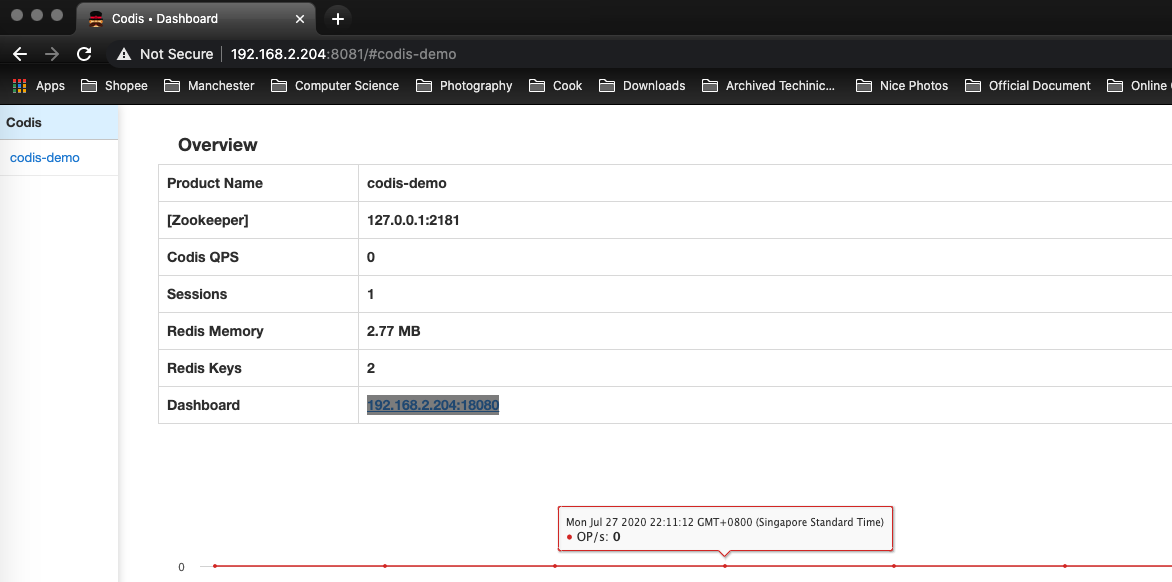
添加 proxy
通过web浏览器访问集群管理页面(即 codis-fe,http://192.168.2.204:8081/ ),在 Proxy 栏我们并不能看到任何codis-proxy。
这其实是由于前面说的,即:
codis-proxy 启动后,处于
waiting状态,监听proxy_addr地址,但是不会accept连接。只要添加到集群并完成集群状态的同步,才能改变状态为
online。添加的方法有以下两种:
- 通过 codis-fe 添加:通过
Add Proxy按钮,将admin_addr加入到集群中;- 通过 codis-admin 命令行工具添加,方法如下:
$ ./bin/codis-admin --dashboard=127.0.0.1:18080 --create-proxy -x 127.0.0.1:11080其中
127.0.0.1:18080以及127.0.0.1:11080分别为 dashboard 和 proxy 的admin_addr地址;
在添加完成后,就可以看到这个proxy的状态了:

同时,在codis-proxy的log中,也能看到对应的变化
2020/07/27 22:53:17 main.go:233: [WARN] [0xc4200a9340] proxy is working ...
添加 codis-group (即codis-server)
Proxy已经设置成功了,但是 Group 栏为空,因为我们启动的 codis-server 并未加入到集群。

GROUP 输入 1,Add Server 输入我们刚刚启动的 codis-server 地址(127.0.0.1:6380),添加到我们刚新建的 Group,然后再点击 Add Server 按钮即可,如上图所示。
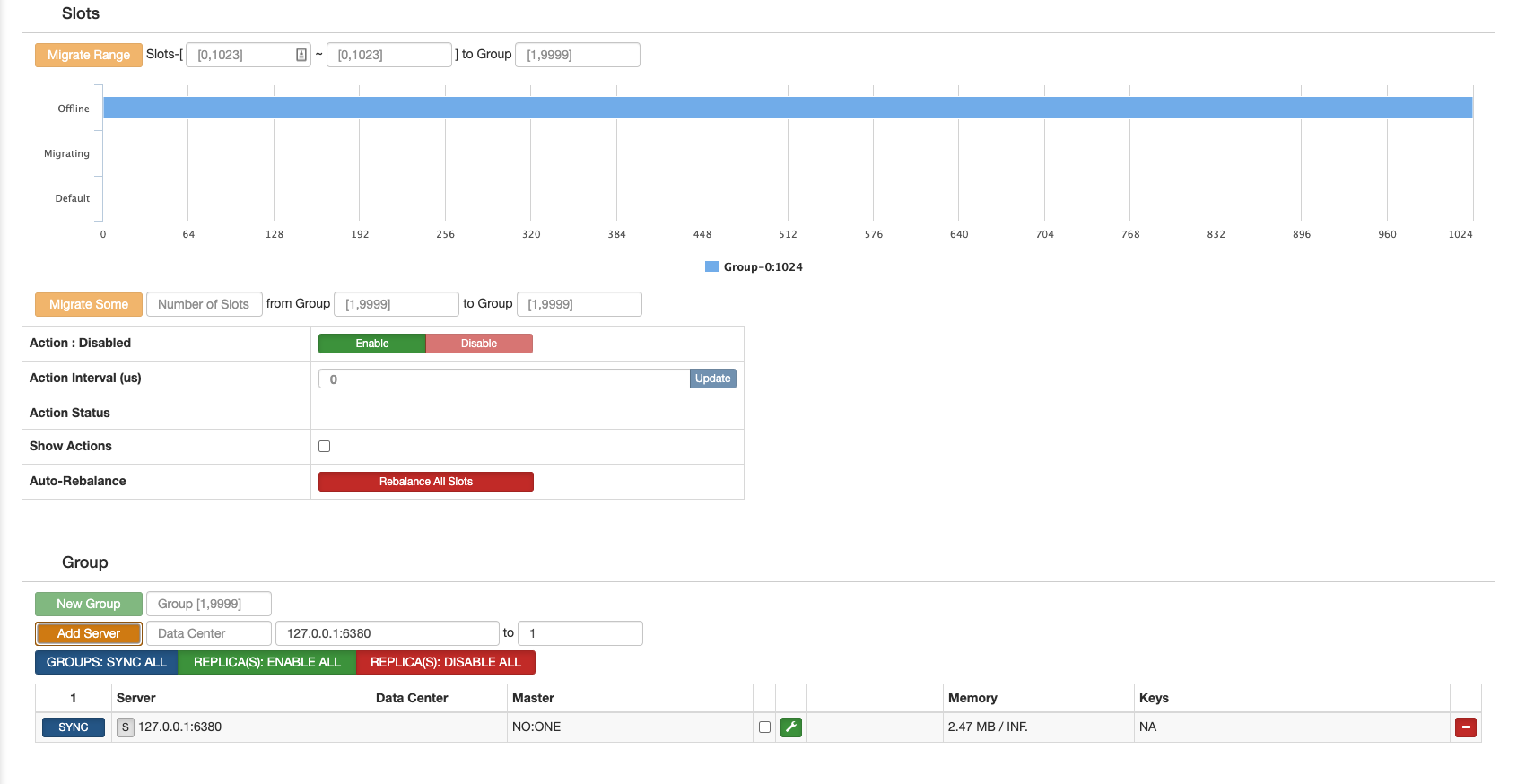
这样以后,整个cluster只有一个Group(即codis-group),即 Group 1。
当然,我们可以将更多个codis-server添加到cluster中,并将这些 codis-server 添加到不同的group中,这就是真正意义上的cluster了。
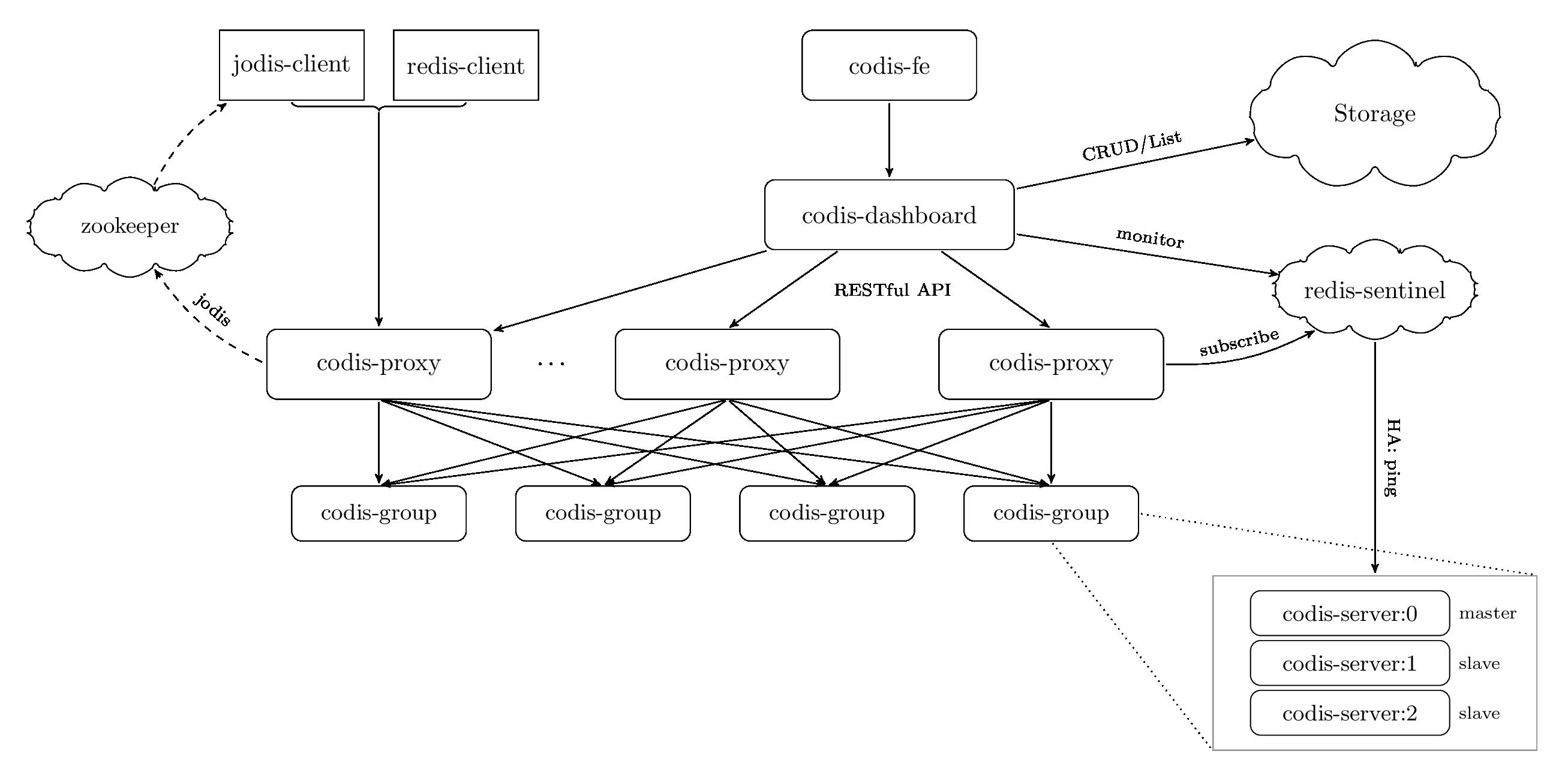
通过codis-fe初始化slot
新增的集群 slot 状态是 offline,因此我们需要对它进行初始化(将 1024 个 slot 分配到各个 group),而初始化最快的方法可通过 fe 提供的 Rebalance All Slots 按钮来做,如下图所示,点击此按钮,我们即快速完成了一个集群的搭建。
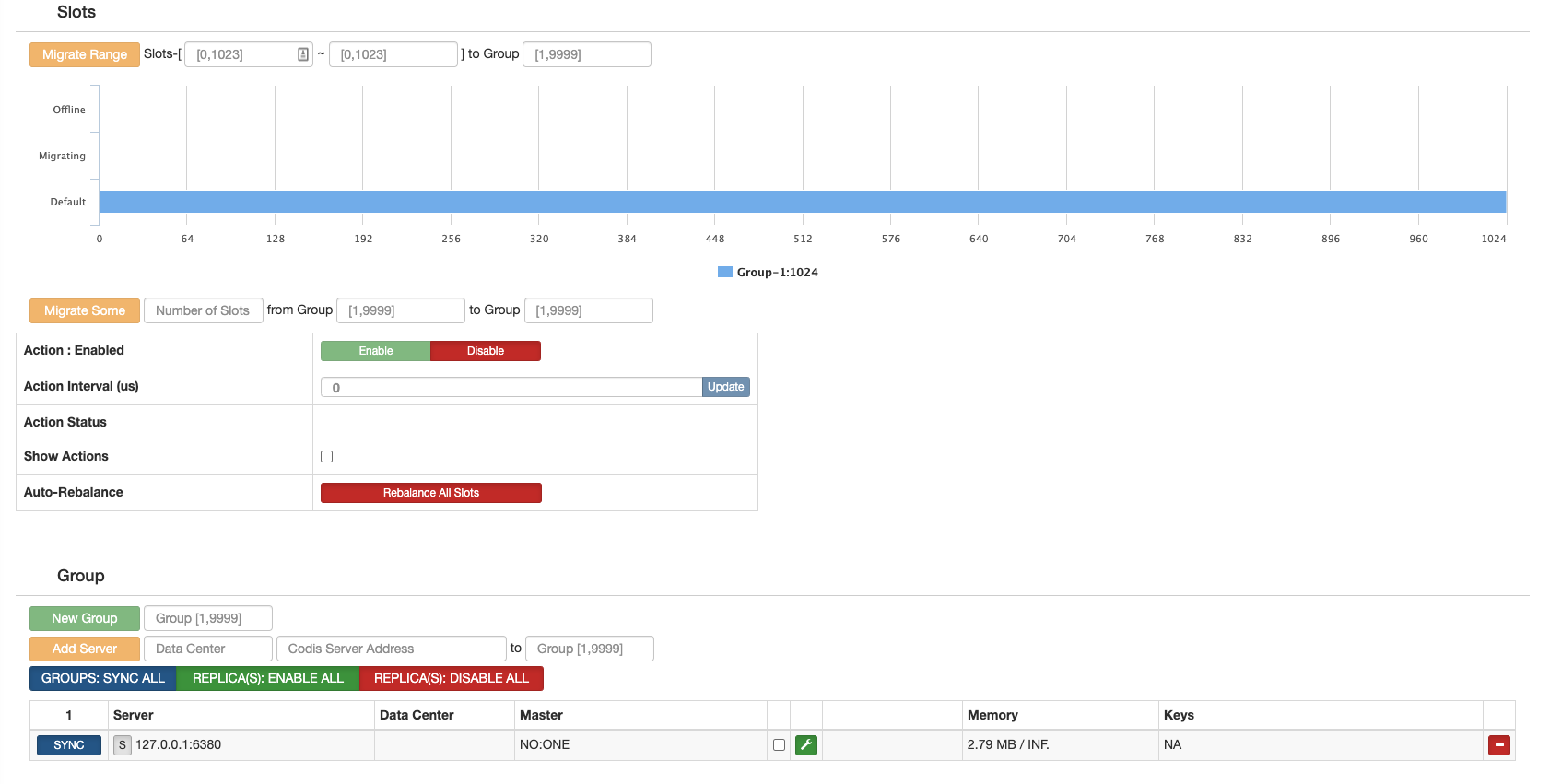
连接到codis-proxy
$ redis-cli -h 192.168.2.204 -p 19000
192.168.2.204:19000> set 1 a
OK
192.168.2.204:19000> set 2 b
OK
当我们进行set 时,就能看到keys的变化:
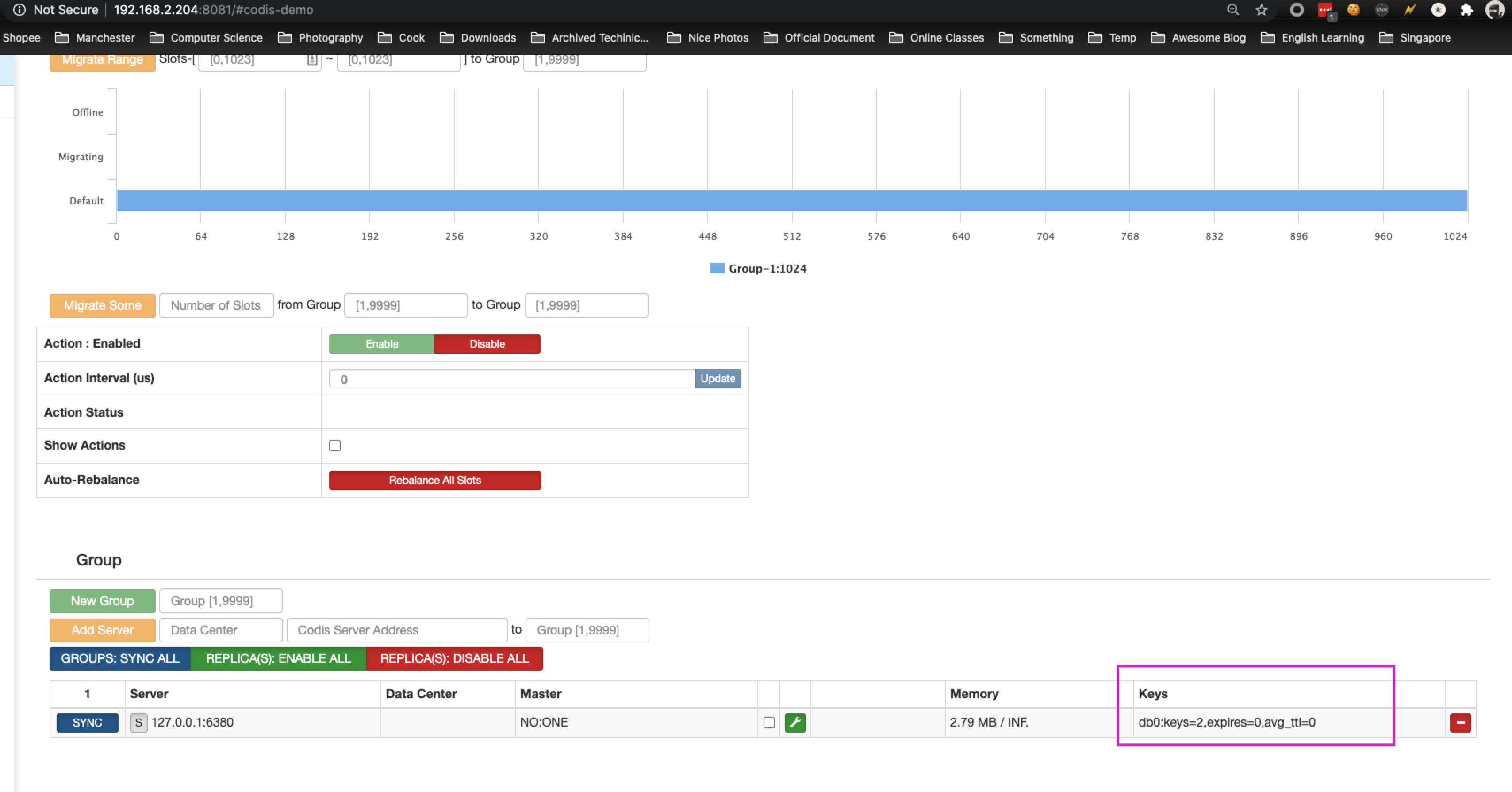
扩展
添加codis-proxy
$ cp config/proxy.toml config/proxy2.toml
$ vim config/proxy2.toml
product_name = "codis-demo"
jodis_name = "zookeeper"
jodis_addr = "127.0.0.1:2181"
admin_addr = "0.0.0.0:11081"
proxy_addr = "0.0.0.0:19001"
$ ./codis-proxy --ncpu=4 --config=config/proxy2.toml
...
2020/07/28 20:49:37 main.go:229: [WARN] [0xc42034c2c0] proxy waiting online ...
启动一个新的codis-proxy,添加其到当前 cluster中:

添加codis-server 作为一个已经存在的codis-group 中的slave节点
$ ./codis-server --port 6381
...
添加该 codis-server 到 Group 1(这也是 codis-server 6380 位于的 Group)中:

点击 127.0.0.1:6381 那一行对应的小扳手,以将数据从 127.0.0.1:6380 复制到 127.0.0.1:6381,即127.0.0.1:6381 作为 127.0.0.1:6380 的 slave节点。
点击后,会有如下Log:
17816:S 28 Jul 21:15:47.703 * SLAVE OF 127.0.0.1:6380 enabled (user request from 'id=36 addr=127.0.0.1:53494 fd=40 name= age=0 idle=0 flags=x db=0 sub=0 psub=0 multi=4 qbuf=0 qbuf-free=32768 obl=50 oll=0 omem=0 events=r cmd=exec')
17816:S 28 Jul 21:15:47.908 * Connecting to MASTER 127.0.0.1:6380
17816:S 28 Jul 21:15:47.909 * MASTER <-> SLAVE sync started
17816:S 28 Jul 21:15:47.909 * Non blocking connect for SYNC fired the event.
17816:S 28 Jul 21:15:47.909 * Master replied to PING, replication can continue...
17816:S 28 Jul 21:15:47.910 * Partial resynchronization not possible (no cached master)
17816:S 28 Jul 21:15:47.911 * Full resync from master: 0ee00b25600eef5b71196377532b70e70fdbbe5a:438
17816:S 28 Jul 21:15:48.006 * MASTER <-> SLAVE sync: receiving 87 bytes from master
17816:S 28 Jul 21:15:48.007 * MASTER <-> SLAVE sync: Flushing old data
17816:S 28 Jul 21:15:48.007 * MASTER <-> SLAVE sync: Loading DB in memory
17816:S 28 Jul 21:15:48.008 * MASTER <-> SLAVE sync: Finished with success
可以看到,数据会被同步:

添加codis-server到一个新的codis-group
添加一个新的group,我们设为group 2:

$ ./codis-server --port 6382
...
添加该 codis-server 到 Group 2中:

这时,所以的数据还只会被存储到 Group 1,因为我们目前还是把所有的slot(slot [0, 1023])分配给了 Group 1,点击"Rebalance All Slots",以重新分配 slots:
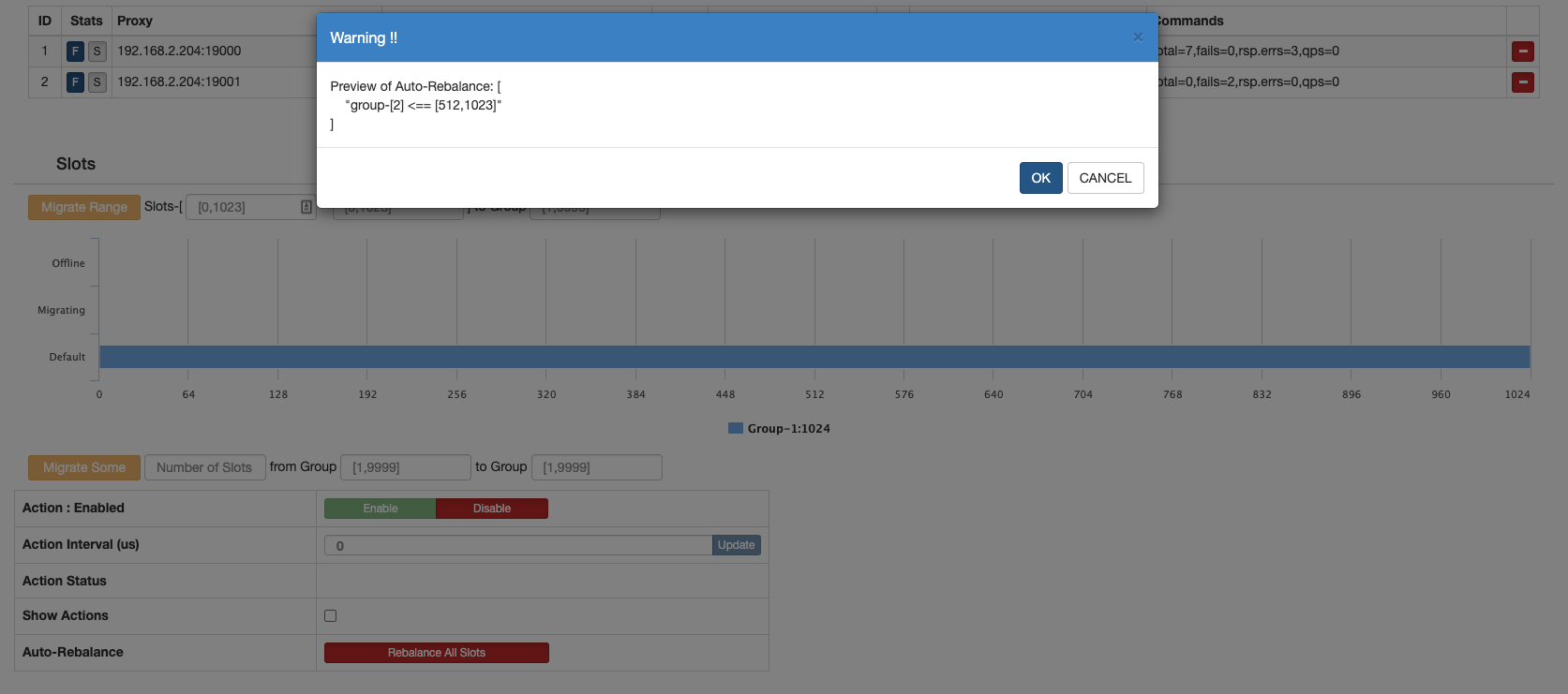
我们随便插入一些数据以做测试:
$ 192.168.2.204:19000> set 1 1
OK
192.168.2.204:19000> set 2 2
OK
192.168.2.204:19000> set 3 3
OK
192.168.2.204:19000> set 4 4
OK
192.168.2.204:19000> set sw sw
OK
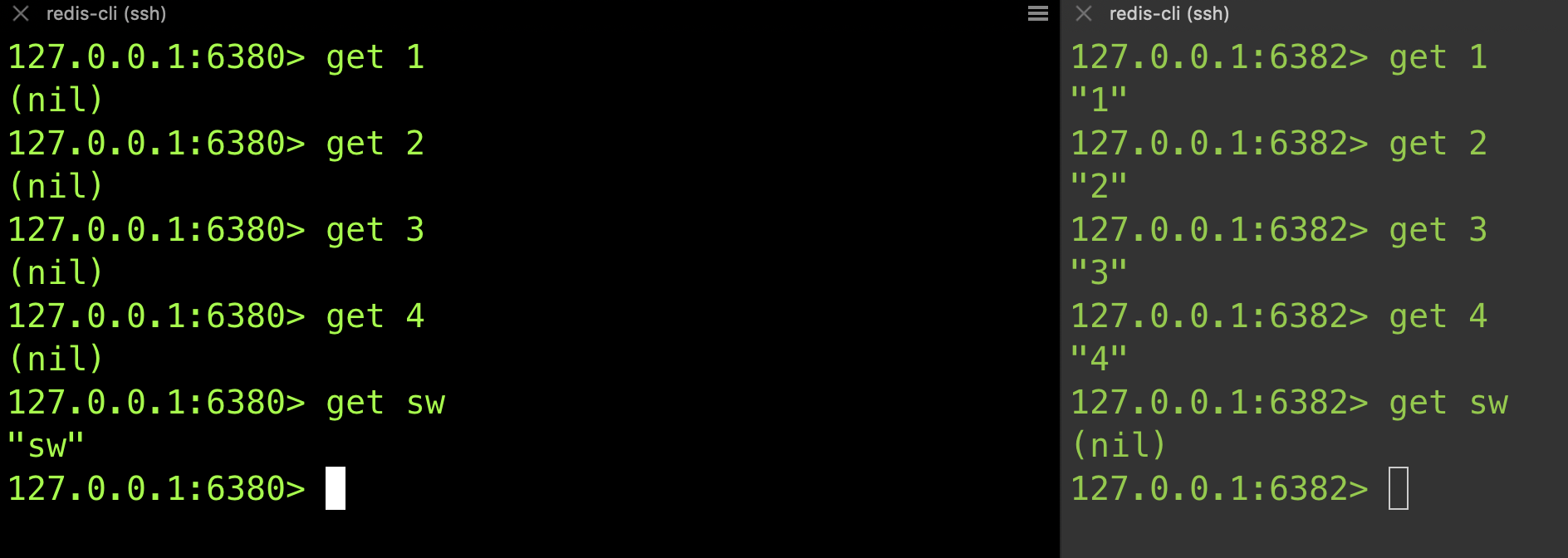
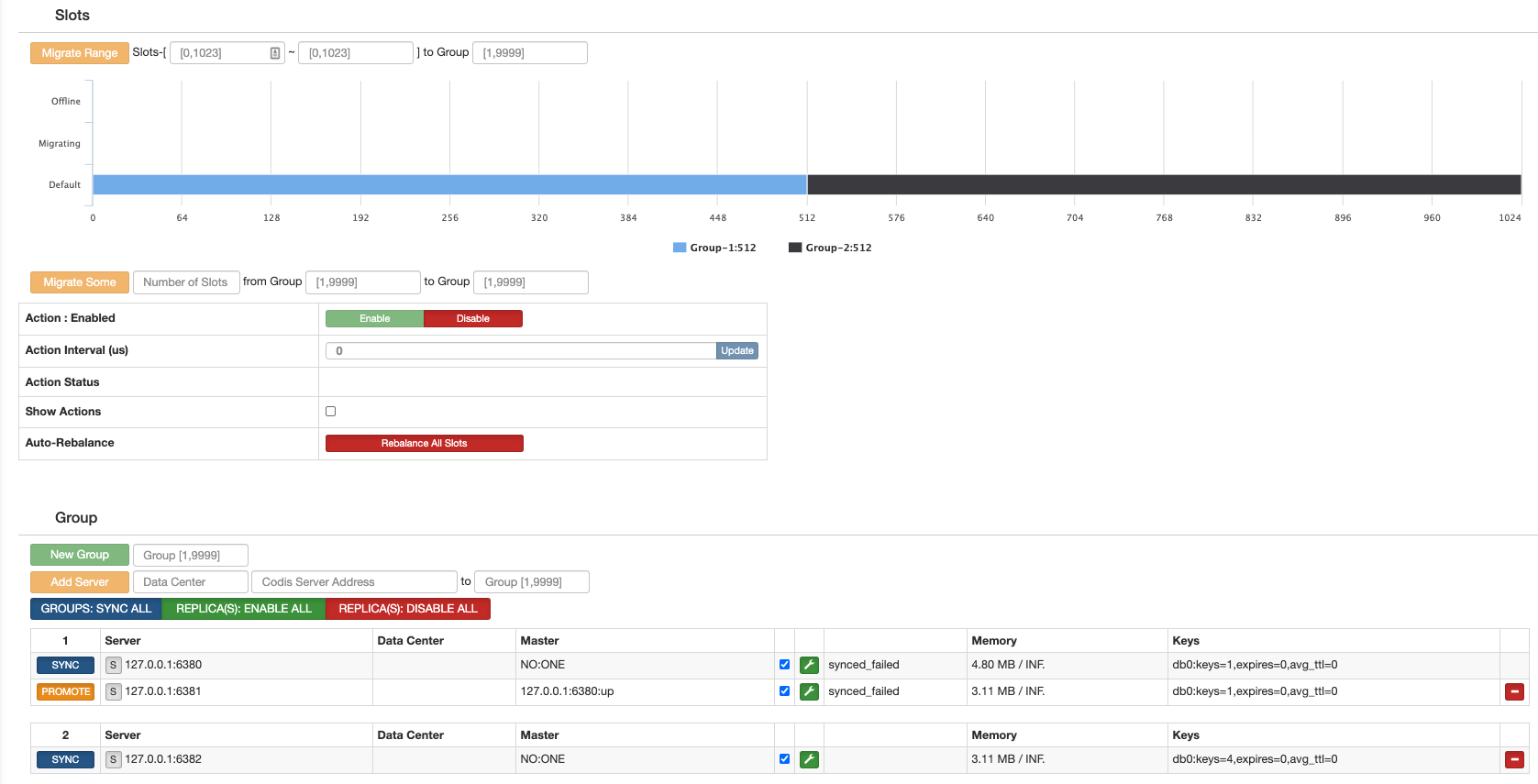
“Rebalance All Slots"可以帮我们很快的完成 cluster的横向扩展(当cluster的容量或者是CPU 成为 bottleneck时),即通过增加codis-group(每个codis-group中只包含一个 master codis-server),并将 slot 重分配到所有 Group 中(这个过程也称为"Rebalance”)。
Observation
codis-proxy 到codis-server 的connection
codis-proxy 会建立多条连接到codis-server,
$ lsof -i -P | grep "codis-pr"
codis-pro 21100 parallels 8u IPv4 2250487 0t0 TCP localhost:60636->localhost:6379 (ESTABLISHED)
codis-pro 21100 parallels 9u IPv4 2252281 0t0 TCP localhost:60638->localhost:6379 (ESTABLISHED)
codis-pro 21100 parallels 10u IPv4 2254068 0t0 TCP localhost:60640->localhost:6379 (ESTABLISHED)
codis-pro 21100 parallels 11u IPv4 2252282 0t0 TCP localhost:60642->localhost:6379 (ESTABLISHED)
codis-pro 21100 parallels 12u IPv4 2252283 0t0 TCP localhost:60644->localhost:6379 (ESTABLISHED)
codis-pro 21100 parallels 13u IPv4 2252284 0t0 TCP localhost:60646->localhost:6379 (ESTABLISHED)
codis-pro 21100 parallels 14u IPv4 2252285 0t0 TCP localhost:60648->localhost:6379 (ESTABLISHED)
codis-pro 21100 parallels 15u IPv4 2254069 0t0 TCP localhost:60650->localhost:6379 (ESTABLISHED)
codis-pro 21100 parallels 16u IPv4 2252286 0t0 TCP localhost:60652->localhost:6379 (ESTABLISHED)
codis-pro 21100 parallels 17u IPv4 2250488 0t0 TCP localhost:60654->localhost:6379 (ESTABLISHED)
codis-pro 21100 parallels 18u IPv4 2253039 0t0 TCP localhost:60656->localhost:6379 (ESTABLISHED)
codis-pro 21100 parallels 19u IPv4 2253040 0t0 TCP localhost:60658->localhost:6379 (ESTABLISHED)
codis-pro 21100 parallels 20u IPv4 2250489 0t0 TCP localhost:60660->localhost:6379 (ESTABLISHED)
codis-pro 21100 parallels 21u IPv4 2250490 0t0 TCP localhost:60662->localhost:6379 (ESTABLISHED)
codis-pro 21100 parallels 22u IPv4 2250491 0t0 TCP localhost:60664->localhost:6379 (ESTABLISHED)
codis-pro 21100 parallels 23u IPv4 2250492 0t0 TCP localhost:60666->localhost:6379 (ESTABLISHED)
而且,可以看到,每启动一个codis-proxy,这个proxy都会和当前active的所有的codis-server建立16个connection:
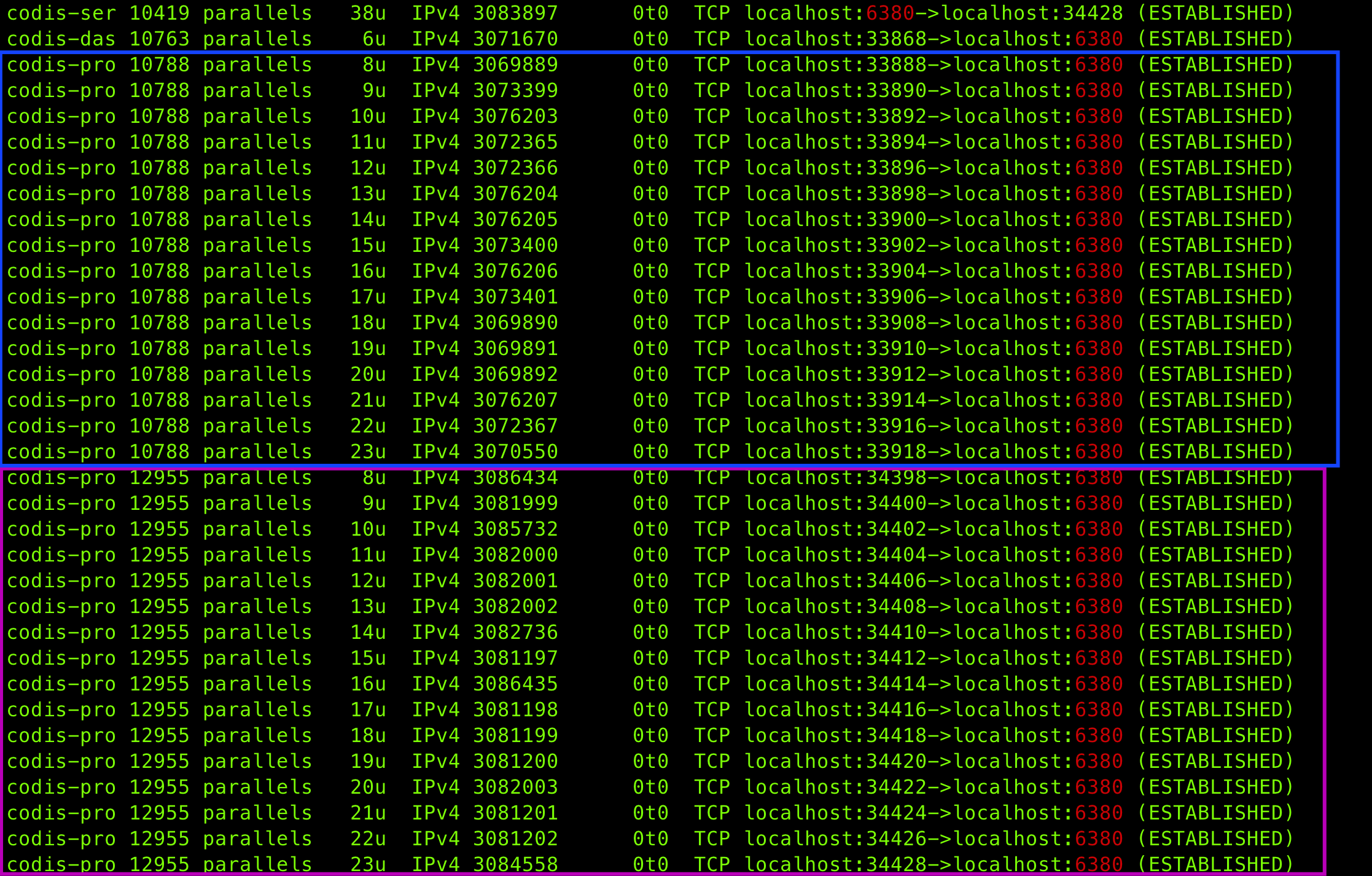
master codis-server 异常时
当master挂了的时候(这里master node是127.0.0.1:6380),slave在默认情况下并不会主动promote成为master(如果设置了sentinel,则会在出现故障时,自动将 Slave Redis node 转换为 Master Redis node)。
虽然我们可以在dashboard中看到error:

同样,通过proxy 来get 数据也会有error:
192.168.2.204:19000> get 1
(error) ERR handle response, backend conn reset
master codis-server 增加后
当 master codis-server 增加后,如预期的,codis-proxy会自动和这个 master codis-server 建立连接,以下是在增加了 127.0.0.1:6382 节点之后,且在"rebalance"之后:
$ lsof -i -P | grep "codis-pro" | grep 12955 | grep 6382 | wc -l
16
错误
Codis异常关闭后启动出错
Situation
2020/07/27 21:25:06 main.go:171: [WARN] [0xc4202d1680] dashboard online failed [15]
2020/07/27 21:25:08 topom.go:189: [ERROR] store: acquire lock of codis-demo failed
[error]: zk: node already exists
6 /home/travis/gopath/src/github.com/CodisLabs/codis/pkg/models/zk/zkclient.go:247
github.com/CodisLabs/codis/pkg/models/zk.(*Client).create
5 /home/travis/gopath/src/github.com/CodisLabs/codis/pkg/models/zk/zkclient.go:196
github.com/CodisLabs/codis/pkg/models/zk.(*Client).Create.func1
4 /home/travis/gopath/src/github.com/CodisLabs/codis/pkg/models/zk/zkclient.go:129
github.com/CodisLabs/codis/pkg/models/zk.(*Client).shell
3 /home/travis/gopath/src/github.com/CodisLabs/codis/pkg/models/zk/zkclient.go:198
github.com/CodisLabs/codis/pkg/models/zk.(*Client).Create
2 /home/travis/gopath/src/github.com/CodisLabs/codis/pkg/models/store.go:119
github.com/CodisLabs/codis/pkg/models.(*Store).Acquire
1 /home/travis/gopath/src/github.com/CodisLabs/codis/pkg/topom/topom.go:188
github.com/CodisLabs/codis/pkg/topom.(*Topom).Start
0 /home/travis/gopath/src/github.com/CodisLabs/codis/cmd/dashboard/main.go:169
main.main
... ...
[stack]:
1 /home/travis/gopath/src/github.com/CodisLabs/codis/pkg/topom/topom.go:189
github.com/CodisLabs/codis/pkg/topom.(*Topom).Start
0 /home/travis/gopath/src/github.com/CodisLabs/codis/cmd/dashboard/main.go:169
main.main
... ...
2020/07/27 21:25:08 main.go:173: [PANIC] dashboard online failed, give up & abort :'(
[stack]:
0 /home/travis/gopath/src/github.com/CodisLabs/codis/cmd/dashboard/main.go:173
main.main
... ...
codis-dashboard 异常退出的修复
当 codis-dashboard 启动时,会在外部存储上存放一条数据,用于存储 dashboard 信息,同时作为 LOCK 存在。当 codis-dashboard 安全退出时,会主动删除该数据。当 codis-dashboard 异常退出时,由于之前 LOCK 未安全删除,重启往往会失败。因此 codis-admin 提供了强制删除工具:
- 确认 codis-dashboard 进程已经退出(很重要);
- 运行 codis-admin 删除 LOCK:
$ ./codis-admin --remove-lock --product=<product name> --zookeeper=<zk address>
# e.g., ./codis-admin --remove-lock --product=codis-demo --zookeeper=127.0.0.1:2181
codis-proxy 异常退出的修复
通常 codis-proxy 都是通过 codis-dashboard 进行移除,移除过程中 codis-dashboard 为了安全会向 codis-proxy 发送 offline 指令,成功后才会将 proxy 信息从外部存储中移除。如果 codis-proxy 异常退出,该操作会失败。此时可以使用 codis-admin 工具进行移除:
- 确认 codis-proxy 进程已经退出(很重要);
- 运行 codis-admin 删除 proxy:
$ ./bin/codis-admin --dashboard=127.0.0.1:18080 --remove-proxy --addr=127.0.0.1:11080 --force
选项 --force 表示,无论 offline 操作是否成功,都从外部存储中将该节点删除。所以操作前,一定要确认该 codis-proxy 进程已经退出。
操作
移除一个 group
$ codis-admin --dashboard=codis-dashboard:18080 --group-del --gid=1 --addr=172.17.0.14:6379
当然也可以通过codis-fe来操作:

使所有slot是offline状态
要保证所有slot是offline状态,让所有slot offline命令如下:
$ ./codis-admin --dashboard=0.0.0.0:18080 --slots-assign --beg=0 --end=1023 --offline --confirm
# 然后再移除这个 group
$ codis-admin --dashboard=codis-dashboard:18080 --group-del --gid=1 --addr=172.17.0.14:6379
总结

-
Codis 最大的优点,就是当cluster的容量或者是CPU 成为 bottleneck时,Codis可以帮我们很快的完成 cluster的横向扩展(通过 “Rebalance All Slots”),即通过增加codis-group(每个codis-group中只包含一个 master codis-server),并将 slot 重分配到所有 Group 中(这个过程也称为"Rebalance")。
-
每个codis-group中只包含一个 master codis-server,当然可以包含0或多个 slave codis-server
Reference
- https://github.com/CodisLabs/codis/blob/release3.2/doc/tutorial_zh.md
- https://blog.csdn.net/u010383937/article/details/83987875
- https://github.com/CodisLabs/codis/issues/1631